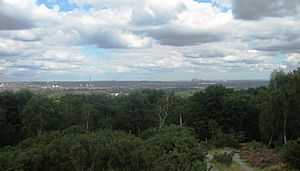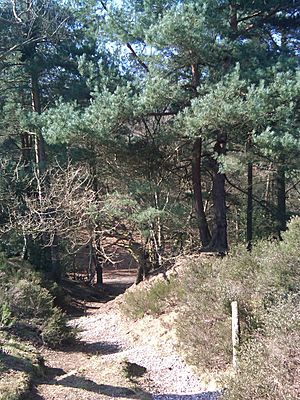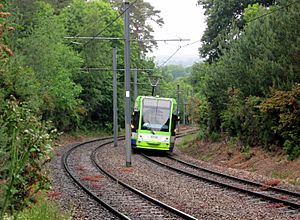Addington Hills facts for kids
Quick facts for kids Addington Hills |
|
|---|---|

View from Addington Hills viewpoint
|
|
| Lua error in Module:Location_map at line 420: attempt to index field 'wikibase' (a nil value). | |
| Type | Public park |
| Location | Shirley |
| Area | 130 acres (53 ha) |
| Operated by | London Borough of Croydon |
| Open | All year |
| Public transit access | Tramlink to Coombe Lane tram stop |
Addington Hills is a lovely park in Upper Shirley, London, England. It's also sometimes called Shirley Hills. The London Borough of Croydon takes care of this special place.
Long ago, Addington Hills was part of an older area called Addington. Later, in the 1930s, the Shirley area grew around it. The park is mostly a forest on top of gravel. It also has the biggest area of heathland in London. Heathland is a type of open land with small shrubs like heather. Because it's so important for nature, it's called a Site of Metropolitan Importance.
Addington Hills and Croham Hurst are popular green spaces in Croydon. They offer a peaceful escape close to the city center. You can find many paths to explore here. There's a great viewpoint where you can see across Croydon and even to north London. You might spot places like Docklands and Parliament Hill.
Getting there is easy! The Tramlink route to New Addington runs along the park's southern edge. You can get off at Coombe Lane tram stop. The park is quite large, covering about 130 acres (that's about 65 football fields!). The London Loop walking path also goes through the park. Addington Hills is open for everyone to enjoy all year round.
Contents
Exploring Addington Hills
Addington Hills rises to 460 feet (140 meters) above sea level. That's like climbing to the top of a 40-story building! The land drops steeply to the north. This shows off the hills' rocky, pebbly ground. Addington Hills is next to Coombe Park / Lloyd Park on its west side. It also borders Coombe Wood to the south.
This area had a different name a long time ago. It was called the hill of Pripledeane or Prible Dean. This name meant "Gravel Valley" in an older form of English. The local health board bought the land in different parts over 45 years to create the park we know today.
Fun Things to Do
Addington Hills has several things to make your visit enjoyable:
- Car parking – You can park off Shirley Hills Road and Oaks Road. There's also parking at the junction with Coombe Lane.
- London Loop path – A long walking trail that goes through the park.
- Chinese restaurant – A place to grab a meal.
- Takeaway coffee – For a quick drink.
- Horse rides – You might see people riding horses here.
- Viewpoint – Don't miss the amazing views!
Cricket History
Addington Hills was once a famous place for cricket games. The first known game here was in 1745. It was played on May 23rd between the Addington team and the London team. Addington won that match!
The park hosted games at least four times between 1745 and 1752. During this time, the Addington Cricket Club was one of the best teams in England. The last known game played here was on August 12, 1752. It was between Addington and the Dartford team.
Plants and Animals
The open heathland areas are full of plants like heather and gorse. You might also spot some bilberry and goldenrod. In drier spots, you'll find bell heather.
The grassy areas have different types of grass, like fescues and wavy hair-grass. You can also see wood sage and heath bedstraw here. In damper spots, look for marsh violet and hard fern. These two plants are quite rare in London!
Many insects, spiders, and other small creatures live in the park. Burrowing bees and wasps make their homes in the bare soil. The bushy heathers and grasses provide shelter for many insects. These creatures are perfectly suited to the warm, dry conditions on the ground.
These small animals are important food for birds and reptiles. Common lizards and slowworms (which look like snakes but are actually legless lizards!) live in the open areas. You might see green woodpeckers in the woods and on the heath. Goldcrests, tiny birds, can be found near the edges of the woods and in the gorse bushes.
Different Types of Land
The northern part of the forest is the oldest. You can see very old oak trees there, especially near Oaks Road. Other wooded areas are much newer. The small pine tree groups near the southern edge were planted in the mid-1800s.
Until the 1920s, Addington Hills had only a few oak, pine, and birch trees. Most of the hills were covered in heather back then. Now, there are many more trees. Heather mostly grows on the slopes and ridges. It can handle the tough conditions there, like very dry and acidic soil.
More Places to Explore
- List of Parks and Open Spaces in Croydon
- Ashburton Park
- Woodside Green
- Brickfields Meadow
- Addington Interchange



